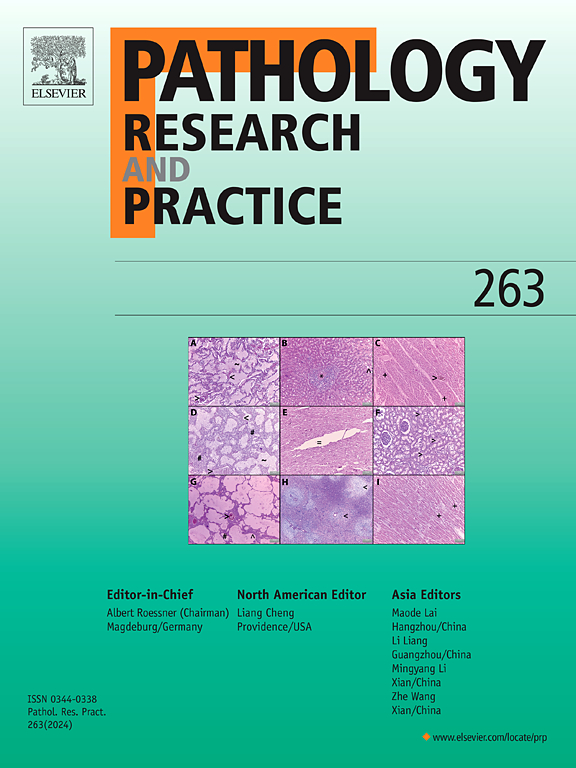Nanomaterials in point-of-care diagnostics: Bridging the gap between laboratory and clinical practice
IF 2.9
4区 医学
Q2 PATHOLOGY
引用次数: 0
Abstract
The integration of nanomaterials into biosensing technologies represents a paradigm shift in medical diagnostics and environmental monitoring, marking a significant advancement in the field. This comprehensive review examines the role of nanomaterials, such as gold nanoparticles, carbon nanotubes, graphene, and quantum dots, in enhancing the performance of biosensors. These nanomaterials contribute unique physical and chemical properties, including exceptional electrical, optical, and thermal conductivities, which significantly improve the sensitivity, specificity, and versatility of biosensors. The review provides an in-depth analysis of the mechanisms by which these nanomaterials enhance biosensor functionality, including increased surface-to-volume ratio, improved electron transfer rates, and enhanced signal transduction. The practical applications of these advanced biosensors are explored across various domains, including oncology, infectious diseases, diabetes management, cardiovascular health, and neurodegenerative conditions, emphasizing their role in early disease detection, real-time health monitoring, and personalized medicine. Furthermore, the review addresses the critical challenges and limitations facing the field, such as biocompatibility, biofouling, stability, and integration into existing healthcare systems. Strategies to overcome these challenges, including advanced material engineering and novel fabrication techniques, are discussed. The future of nanomaterial-based biosensors is envisioned through the lens of emerging trends and technological innovations. The integration with microfluidics, artificial intelligence, and wearable technology is highlighted as a path toward more personalized, efficient, and accessible healthcare solutions. This review underscores the transformative impact of nanomaterials in biosensing, projecting a future where these advanced technologies play a pivotal role in reshaping diagnostics, patient care, and environmental monitoring, thereby significantly enhancing healthcare and public health outcomes.
护理点诊断中的纳米材料:弥合实验室与临床实践之间的差距
将纳米材料融入生物传感技术代表着医学诊断和环境监测领域的范式转变,标志着该领域的重大进展。本综述探讨了金纳米粒子、碳纳米管、石墨烯和量子点等纳米材料在提高生物传感器性能方面的作用。这些纳米材料具有独特的物理和化学特性,包括优异的电导率、光导率和热导率,可显著提高生物传感器的灵敏度、特异性和多功能性。综述深入分析了这些纳米材料增强生物传感器功能的机制,包括提高表面体积比、改善电子传输速率和增强信号传导。文章探讨了这些先进生物传感器在各个领域的实际应用,包括肿瘤学、传染病、糖尿病管理、心血管健康和神经退行性疾病,强调了它们在早期疾病检测、实时健康监测和个性化医疗中的作用。此外,该综述还探讨了该领域面临的重大挑战和限制,如生物兼容性、生物污染、稳定性以及与现有医疗系统的整合。讨论了克服这些挑战的策略,包括先进的材料工程和新型制造技术。从新兴趋势和技术创新的角度展望了基于纳米材料的生物传感器的未来。重点介绍了与微流控、人工智能和可穿戴技术的整合,认为这是实现更个性化、更高效和更便捷的医疗解决方案的途径。这篇综述强调了纳米材料在生物传感方面的变革性影响,预测了这些先进技术在重塑诊断、病人护理和环境监测方面发挥关键作用的未来,从而显著提高医疗保健和公共卫生成果。
本文章由计算机程序翻译,如有差异,请以英文原文为准。
求助全文
约1分钟内获得全文
求助全文
来源期刊
CiteScore
5.00
自引率
3.60%
发文量
405
审稿时长
24 days
期刊介绍:
Pathology, Research and Practice provides accessible coverage of the most recent developments across the entire field of pathology: Reviews focus on recent progress in pathology, while Comments look at interesting current problems and at hypotheses for future developments in pathology. Original Papers present novel findings on all aspects of general, anatomic and molecular pathology. Rapid Communications inform readers on preliminary findings that may be relevant for further studies and need to be communicated quickly. Teaching Cases look at new aspects or special diagnostic problems of diseases and at case reports relevant for the pathologist''s practice.

 求助内容:
求助内容: 应助结果提醒方式:
应助结果提醒方式:


